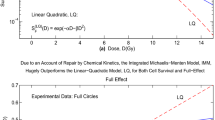Abstract
Recent findings demonstrate that accelerated carcinogenesis following liver regeneration is associated with chronic inflammation-induced double-strand DNA breaks in cells, which escaped apoptosis due to proliferative stress. In this work, proliferative stress and inflammation-based carcinogenesis at large dose were included in a cancer induction model considering fractionation. At large dose, tissue injury due to irradiation could be so severe that under the regenerative proliferative stress induced by cell loss, the genomic unstable cells generated during irradiation and/or inflammation escape senescence or apoptosis and reenter the cell cycle, triggering enhanced carcinogenesis. This acceleration—modeled to be proportional to the number of repopulated cells—is only significant, however, when tissue injury is severe and thus proportional to the cell loss in the tissue. The general solutions to the resulting differential equations for carcinoma induction were computed. In case of full repopulation or acute low-dose irradiation, the acceleration term disappears from the equation describing cancer induction. The acceleration term is affecting the dose–response curve for carcinogenesis only at large doses. An example for bladder cancer is shown. An existing model for cancer induction after fractionated radiotherapy which is based on cell mutations was extended here by including the effects of inflammation and proliferative stress, and an additional model parameter was established which describes acceleration. The new acceleration parameter affects the dose–response model only at large dose and is only effective when the tissue is not capable of fully repopulating between dose fractions.



Similar content being viewed by others
References
Barash HR, Gross E, Edrei Y, Ella E, Israel A, Cohen I, Corchia N, Ben-Moshe T, Pappo O, Pikarsky E, Goldenberg D, Shiloh Y, Galun E, Abramovitch R (2010) Accelerated carcinogenesis following liver regeneration is associated with chronic inflammation-induced double-strand DNA breaks. Proc Natl Acad Sci USA 107(5):2207–2212
Bartkova J, Horejsí Z, Koed K, Krämer A, Tort F, Zieger K, Guldberg P, Sehested M, Nesland JM, Lukas C, Ørntoft T, Lukas J, Bartek J (2005) DNA damage response as a candidate anti-cancer barrier in early human tumorigenesis. Nature 434:864–870
Brenner DJ, Curtis RE, Hall EJ, Ron E (2000) Second malignancies in prostate carcinoma patients after radiotherapy compared with surgery. Cancer 88(2):398–406
Dörr W, Kummermehr J (1990) Accelerated repopulation of mouse tongue epithelium during fractionated irradiations or following single doses. Radiother Oncol 17(3):249–259
Hall EJ (2000) Radiation, the two-edged sword: cancer risks at high and low doses. Cancer J 6:343–350
Newhauser WD, Durante M (2011) Assessing the risk of second malignancies after modern radiotherapy. Nat Rev Cancer 11:38–448
Pfaffenberger A, Schneider U, Poppe B, Oelfke U (2009) Phenomenological modelling of second cancer incidence for radiation treatment planning. Z Med Phys 19(4):236–250
Philip M, Rowley DA, Schreiber H (2004) Inflammation as a tumor promoter in cancer induction. Semin Cancer Biol 14(6):433–439
Preston DL, Ron E, Tokuoka S, Funamoto S, Nishi N, Soda M, Mabuchi K, Kodama K (2007) Solid cancer incidence in atomic bomb survivors: 1958–1998. Radiat Res 168(1):1–64
Rowland J, Mariotto A, Aziz N, Tesauro G, Feuer EJ (2004) Cancer survivorship-United States, 1971–2001. MMWR Morb Mortal Wkly Rep 53:526–529
Sachs RK, Brenner DJ (2005) Solid tumor risks after high doses of ionizing radiation. Proc Natl Acad Sci USA 102:13040–13045
Schneider U (2009) Mechanistic model of radiation-induced cancer after fractionated radiotherapy using the linear-quadratic formula. Med Phys 36:1138–1143
Schneider U, Walsh L (2008) Cancer risk estimates from the combined Japanese A-bomb and Hodgkin cohorts for doses relevant to radiotherapy. Radiat Environ Biophys 47(2):253–263
Schneider U, Sumila M, Robotka J (2011) Site-specific dose-response relationships for cancer induction from the combined Japanese A-bomb and Hodgkin cohorts for doses relevant to radiotherapy. Theor Biol Med Model 8:27
Shuryak I, Hahnfeldt P, Hlatky L, Sachs RK, Brenner DJ (2009a) A new view of radiation-induced cancer: integrating short- and long-term processes. Part I: approach Radiat Environ Biophys 48: 263–274; Erratum (2011) Radiat Environ Biophys 50: 607–608
Shuryak I, Hahnfeldt P, Hlatky L, Sachs RK, Brenner DJ (2009b) A new view of radiation-induced cancer: integrating short- and long-term processes. Part II: second cancer risk estimation Radiat Environ Biophys 48: 275–286; Erratum (2011) Radiat Environ Biophys 50: 607–608
Suit H, Goldberg S, Niemierko A, Ancukiewicz M, Hall E, Goitein M, Wong W, Paganetti H (2007) Secondary carcinogenesis in patients treated with radiation: A review of data on radiation-induced cancers in human, non-human primate, canine and rodent subjects Radiat Res 167: 12–42; Erratum. 2007. Radiat Res 167: 748
Van Gent DC, Hoeijmakers JHJ, Kanaar R (2001) Chromosomal stability and the DNA double-stranded break connection. Nat Rev Genet 2:196–206
Author information
Authors and Affiliations
Corresponding author
Rights and permissions
About this article
Cite this article
Schneider, U., Schäfer, B. Model of accelerated carcinogenesis based on proliferative stress and inflammation for doses relevant to radiotherapy. Radiat Environ Biophys 51, 451–456 (2012). https://doi.org/10.1007/s00411-012-0433-x
Received:
Accepted:
Published:
Issue Date:
DOI: https://doi.org/10.1007/s00411-012-0433-x




